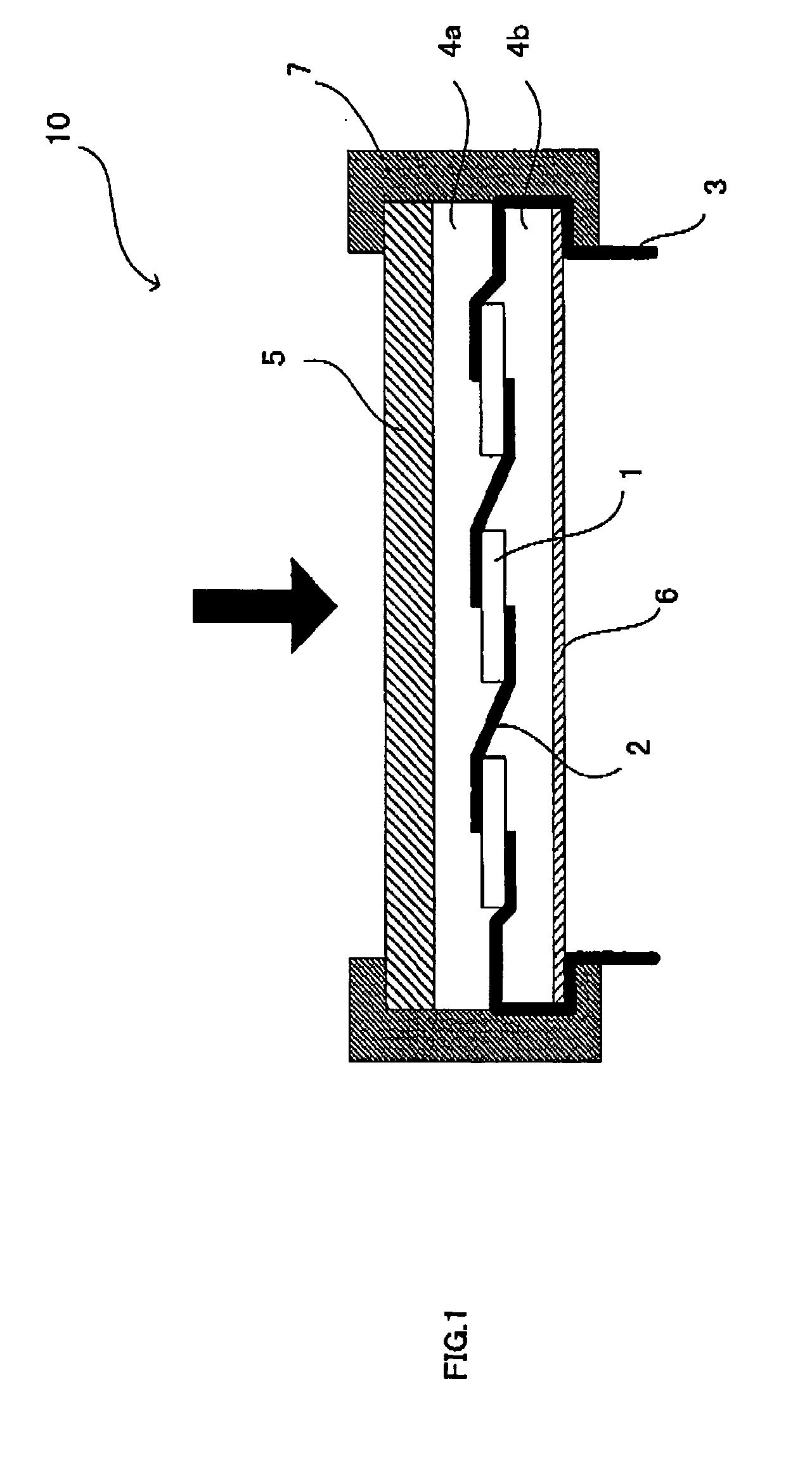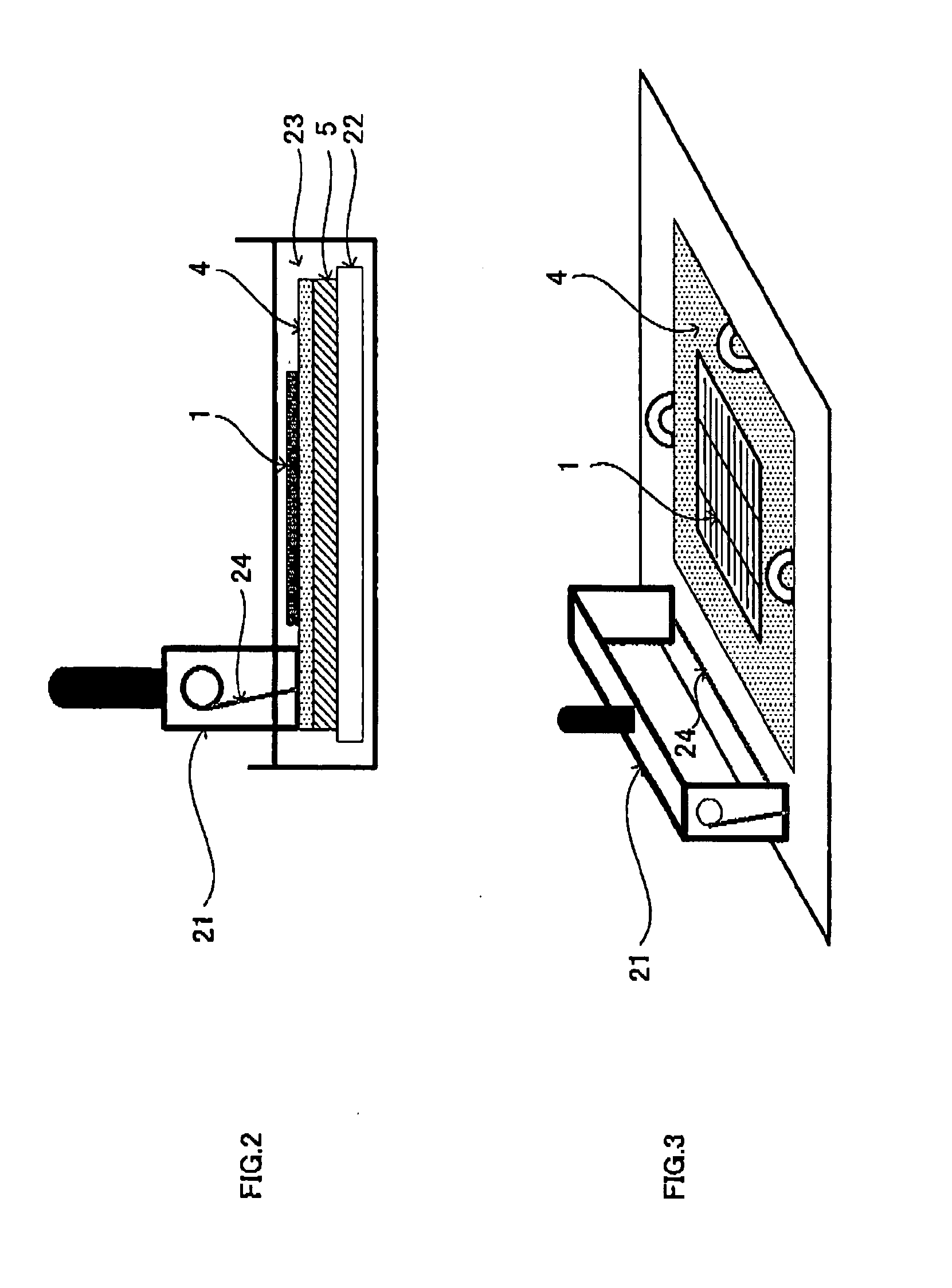Encapsulant layer for photovoltaic module, photovoltaic module and method for manufacturing regenerated photovoltaic cell and regenerated transparent front face substrate
a photovoltaic module and photovoltaic cell technology, applied in the field of photovoltaic module encapsulation layer, can solve the problems of further significant cost reduction, increased production, and difficulty in recovering a transparent front face substrate and a photovoltaic cell from a used module, and achieves the effect of easy recovery and easy separation
- Summary
- Abstract
- Description
- Claims
- Application Information
AI Technical Summary
Benefits of technology
Problems solved by technology
Method used
Image
Examples
example 1
(1) Production of Encapsulant Layer
100 parts by weight of a straight chain low density polyethylene having a Vicat softening temperature, measured based on JIS standard K7206 (hereinafter, referred to as Vicat softening temperature), of 80° C., a melting temperature of 90° C., a melt mass flow rate (hereinafter, referred to as MFR) of 2 g / 10 min at 190° C. and a density of 0.898 g / cm3, 2.0 parts by weight of vinyltrimethoxysilane and 0.1 part by weight of a free radical generator (t-butyl-peroxy isobutyrate) were mixed and graft-polymerized at a melt stirring temperature of 200° C. to cause silane modification, manufacturing a silane-modified straight chain low density polyethylene.
3.75 parts by weight of a hindered amine-based photo-stabilizer, 3.75 parts by weight of a benzotriazole-based ultraviolet absorber and 0.5 parts by weight of a phosphorus-based thermal-stabilizer were mixed based in 100 parts by weight of the straight chain low density polyethylene and they were mel...
example 2
The same silane-modified straight chain low density polyethylene as in Example 1 was manufactured, and the same master batch as in Example 1 was manufactured.
100 parts by weight of the above mentioned silane-modified straight chain low density polyethylene and 5 parts by weight of the above mentioned waster batch were mixed, and a film of 400 μm was formed in the same manner as in Example 1.
Film formation could be conducted without problems. The appearance and total ray transmittance of the resulting film were excellent. The polymerized Si amount in the resulting film was 3000 ppm.
A photovoltaic module was manufactured in the same manner as in Example 1. The encapsulant layer was cut out from the resulting photovoltaic module, and its gel fraction was measured to be 0%.
example 3
The same silane-modified straight chain low density polyethylene as in Example 1 was manufactured, and the same master batch as in Example 1 was manufactured.
1. Separable Layer (Outer Layer)
To 20 parts by weight of the above mentioned silane-modified straight chain low density polyethylene, 80 parts by weight of a straight chain low density polyethylene having a Vicat softening temperature of 70° C., a melting temperature of 90° C., a MFR of 3.5 g / 10 min at 190° C. and a density of 0.900 g / cm3 and 5 parts by weight of the above mentioned master batch were added and mixed.
2. Filling Layer (Inner Layer)
A straight chain low density polyethylene, having a Vicat softening temperature of 75° C., a melting temperature of 100° C., a MFR of 3.5 g / 10 min at 190° C. and a density of 0.902 g / cm3, was used.
The above mentioned separable layer and filling layer were laminated in the order of separable layer, filling layer and separable layer. The film thickness ratio was 1:6:1. In manuf...
PUM
| Property | Measurement | Unit |
|---|---|---|
| melt mass flow rate | aaaaa | aaaaa |
| Vicat softening temperature | aaaaa | aaaaa |
| total ray transmittance | aaaaa | aaaaa |
Abstract
Description
Claims
Application Information
 Login to View More
Login to View More - R&D
- Intellectual Property
- Life Sciences
- Materials
- Tech Scout
- Unparalleled Data Quality
- Higher Quality Content
- 60% Fewer Hallucinations
Browse by: Latest US Patents, China's latest patents, Technical Efficacy Thesaurus, Application Domain, Technology Topic, Popular Technical Reports.
© 2025 PatSnap. All rights reserved.Legal|Privacy policy|Modern Slavery Act Transparency Statement|Sitemap|About US| Contact US: help@patsnap.com



